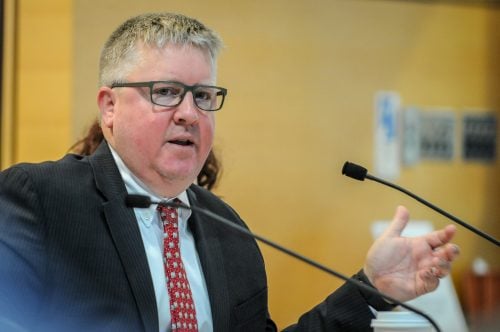
(Photos: Jonathan Maus)
At a meeting of a high-powered Metro policy committee yesterday, the Oregon Department of Transportation was put in the hot seat over their plans to widen Interstate 5 through the Rose Quarter. Peppered with questions from Metro Councilor Bob Stacey, the regional director of ODOT Rian Windsheimer, was forced to came to the aid of an ODOT staff member who was presenting on the project.
Windsheimer’s move demonstrated that sharp criticisms from a gathering storm of activists are gaining strength from elected leaders like Stacey, testing ODOT’s nerves and putting the agency on the defensive. The meeting also made it clear that, while initially sold by ODOT to the public and politicians as a “bottleneck elimination” project, the agency is now reluctant to claim it will lead to any capacity increase.
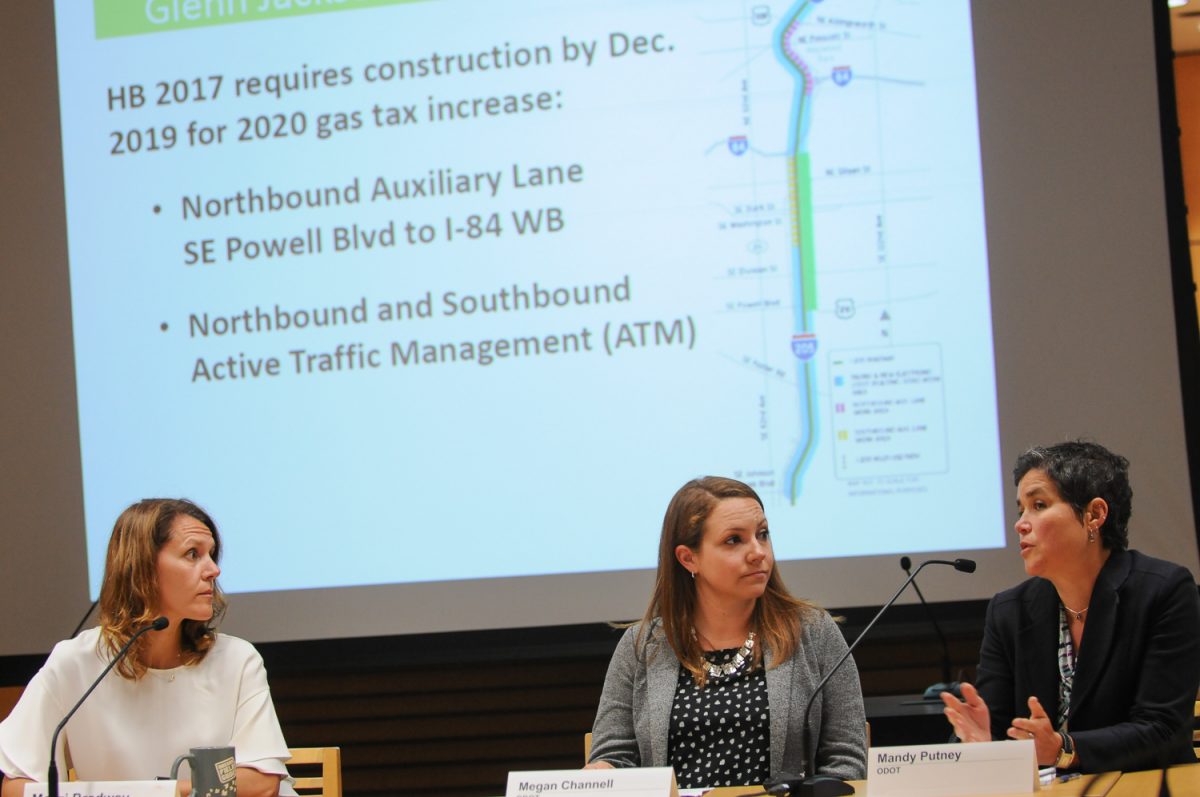
The exchange between Stacey, Windsheimer, and ODOT project manager Mandy Putney came after a presentation where another ODOT staffer, Megan Channell outlined three major highway projects the agency is working on. Projects that will add lanes to I-205, I-217, and I-5 are already slated to cost $1.1 billion — a number sure to increase when (or if) the projects are finished sometime around 2027. The I-5 Rose Quarter project is the most controversial of the three, given its proximity to downtown Portland and the historic Albina neighborhood.
“I don’t know how on earth we can reconcile any ostensible commitment to restorative justice for this neighborhood by poisoning the air to the point where we recommend children stay indoors.”
— Aaron Brown, No More Freeways PDX
In their presentation to the Joint Policy Advisory Committee on Transportation yesterday, ODOT said the I-5 project could cost up to $500 million when it’s all said and done. The State Legislature has already committed $400 to $420 million in bonding revenue via the transportation package they passed in 2017.
Prior to the presentation, the assembled committee members — including mayors and other elected officials, as well as senior agency staff from around the region — heard public testimony from Aaron Brown, leader of the No More Freeways PDX coalition. Brown offered stinging criticisms of ODOT’s plans for the Rose Quarter. He referenced the nascent Albina Vision plan which seeks to restore the historic neighborhood that existed in the area before it was razed for sports stadiums and freeways in the name of “urban renewal.”
“The project ODOT is proposing in this neighborhood,” Brown said, “Is directly antithetical to the transformative and restorative opportunity which the Albina Vision is promoting.” Brown also said the project will have a negative impact on Harriet Tubman Middle School, a school with a majority of low-income students of color. ODOT’s plans will carve into the existing planted area between the school and the freeway, putting a new lane within yards of its classrooms. “The school has such poor air quality that public health researchers recommended students not be given outdoor recess,” he said. “I don’t know how on earth we can reconcile any ostensible commitment to restorative justice for this neighborhood by poisoning the air to the point where we recommend children stay indoors. That’s out of a Ray Bradbury novel.”
Advertisement
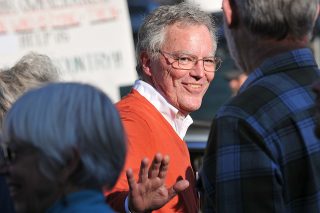
Brown found a supportive ear in Metro Councilor Bob Stacey.
Stacey is concerned ODOT has taken the easy way out when it comes to environmental review of the project. ODOT has opted to do an Environmental Assessment (EA) instead of the much more rigorous Draft Environmental Impact Statement (DEIS) — a move that has also been flagged by environmental and social justice groups. Given the emergence of the Albina Vision plan since the project was adopted in 2012, and its proximity to a Title I school, Stacey invoked the Civil Rights Act in his call for a more robust analysis of the project’s potential impacts. ODOT staff assured him their assessment will be adequate; but Stacey told me in an interview after the meeting that, “I think it’s prudent of ODOT to use all the tools of engagement. My concern is that their EA won’t vet community concerns and I’ll be watching this very closely.”
Stacey also pressed ODOT staff about whether or not the project will increase capacity through the Rose Quarter, setting up a somewhat testy exchange.
“I presume that the State of Oregon and City of Portland believe more vehicles will be able to pass through this portion of I-5 as a result of this project?” Stacey questioned. “I happen to agree with Mr. [Aaron] Brown that they will go as slowly as the traffic does today once people adjust to the new capacity.”
“It will still be two lanes of I-5 northbound in, and two lanes of I-5 northbound out. It is not increasing — as you’re describing — a big throughput capacity.”
— Rian Windsheimer, ODOT
ODOT’s Mandy Putney then tried to explain that the I-5 project won’t add any new capacity. “Rose Quarter is an operational project,” she said. “We’re adding an auxiliary lane to allow people to merge more easily between very closely spaced ramps… Rose Quarter will have the same number of general purpose lanes in the future as it does today.”
Stacey replied, “Will it have increased capacity though?”
“It will allow people to move more safely through the area,” Putney replied.
At that point ODOT Region 1 Director Rian Windsheimer interjected, “It will still be two lanes of I-5 northbound in, and two lanes of I-5 northbound out. It is not increasing — as you’re describing — a big throughput capacity. It’s allowing what’s there today to function better. There will only be two lanes in and two lanes out… it’s the same. This is about allowing the high volumes from I-84 to merge into that same area.”
Merging and safety aside, ODOT’s own presentation yesterday pointed out that the project will save an estimated 2.5 million hours of vehicle delay each year. If people are able to drive more quickly through this section of freeway, isn’t it obvious that more of them will move through it?
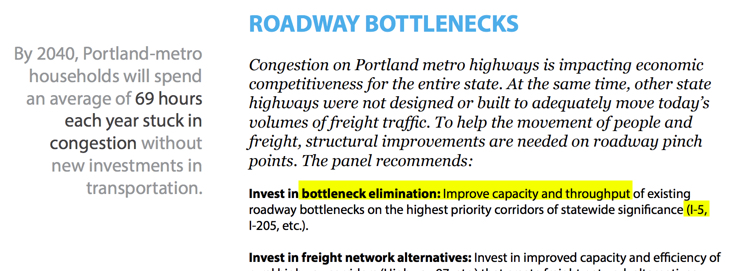
ODOT’s reluctance to openly admit a capacity increase is noteworthy. When political groundwork was laid for this project, “reducing congestion” and “bottleneck elimination” were key to winning over the public and legislators (see above). But now that funding is secured, they say it’s all about safety and operational improvements. More capacity wasn’t mentioned when ODOT’s Megan Channell stated the project goal yesterday: “To create a safer and more reliable I-5, a better connected community, and an opportunity for economic growth.”
In a post-meeting interview Stacey said, “I think that’s a refreshing acknowledgment that this is not a project that will help traffic move more freely. It will reduce the number of fender-benders that occur in that area. That might allow a little bit of 35 mph travel instead of 20 mph travel; but as he [Windsheimer] says, they don’t expect it’s going to make a difference in terms of through-put.” “Fair enough,” he continued. “So again, why do we need to spend this much money?”
Stacey also sees a bit of a bait-and-switch in the way ODOT has sold the project to the public. “It [the honesty about no capacity increase] is a little late in terms of overall public decision-making, including the legislative decision-making,” he said. “I don’t know if anyone from ODOT expressly told the committee [of legislators in Salem], ‘Hey, just so we’re clear, there’s not going to be a single additional truck going through there, we’ll just have fewer dents on the trucks.”
— Jonathan Maus: (503) 706-8804, @jonathan_maus on Twitter and jonathan@bikeportland.org
Never miss a story. Sign-up for the daily BP Headlines email.
BikePortland needs your support.

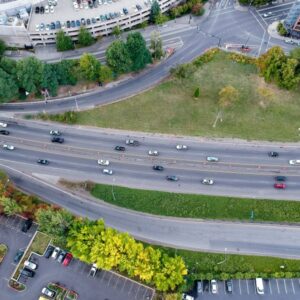
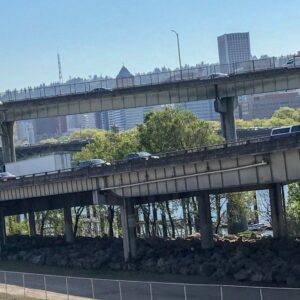
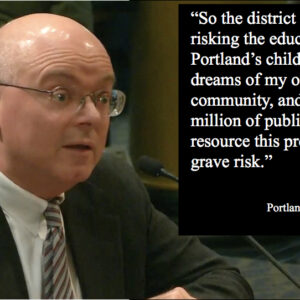
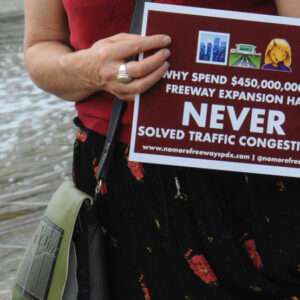
Thanks for reading.
BikePortland has served this community with independent community journalism since 2005. We rely on subscriptions from readers like you to survive. Your financial support is vital in keeping this valuable resource alive and well.
Please subscribe today to strengthen and expand our work.
Utter failure on ODOT’s part.
Someone should clean house over there. Start over from scratch.
Kate Brown is ODOT’s boss. The corporate-funded democratic party owns this 100%.
Don’t know if Kate personally backs this boondoggle, but Knute Buehler certainly does. Google it.
ODOT has made it clear that their only desire and purpose is to lay down as much asphalt as possible. They would say that it is not their job to consider pollution, climate change, equity or efficient transportation. In ODOTs eyes, that is the job of the state legislature and the governor, and if Kate Brown and ORleg don’t stop them from spending excessive amounts of the state budget on pointless freeway expansions it is their own fault. If metro, PDX city council, or state admin believe ODOTs specious claims, then it is their own fault. And here we are, with state and city government that is not sophisticated enough to manage ODOT, expecting ODOT to voluntarily restrain themselves and not build roads that we don’t need.
Wow, that’s a particularly nasty political comment.
Please supply a list of all supporters and detractors and their political affiliations.
I’d also like to know why you think democrats are pro-corporation more than republicans. I thought it was the other way around.
And 5 seconds on Orestar shows that Kate Brown’s top political contribution comes from a Wall Street billionaire.
Sooo, no increased capacity, but fewer (non-fatal, fender-bender) accidents. Even back of the napkin math takes the air right out of this idea. Let’s say 2 fender-benders a day with out of pocket costs of $500 per (deductible). We’re spending $400 million+ to save $300-400K in taxpayer costs. It would take 1,000 years for the investment to be worth it. Yes, it is true that insurers pay more for repairs for these accidents, but why spend taxpayer money to reduce insurer liability unless insurers are either funding the work or agreeing to lower premiums? I know many drive without insurance, but that misses the point. I’m not hearing that this project is intended to decrease injury/fatality crashes; just quicken speeds and reduce minor crashes. Sounds like a substantial misuse of public funds to me.
And of course, the above doesn’t even acknowledge the impact to the adjacent neighborhood and school……
Many thanks to the advocates who are speaking out against this project.
Oh, and don’t forget the old canard: idling cars produce more pollution that faster moving cars…. Some folks love to trot that out as a last ditch effort to rescue their indefensible road widening project.
That old canard may be true. https://www.environmentalleader.com/2012/01/how-traffic-jams-affect-air-quality/
“It seems intuitive that your car burns more fuel the faster you go. But the truth is that your car burns the most fuel while accelerating to get up to speed. Maintaining a constant speed against wind-resistance burns more or less a constant amount. It’s when you find yourself in a sea of orange traffic cones — stuck in what looks more like a parking lot than a highway — that your car really starts eating up gas. The constant acceleration and braking of stop-and-go traffic burns more gas, and therefore pumps more pollutants into the air.
The relationship between driving speed and pollution isn’t perfectly linear, though. One study suggests that emissions start to go up when average freeway speed dips below 45 miles per hour (mph). They also start to go up dramatically as the average speed goes above 65 mph. So, the “golden zone” for fuel-consumption and emissions from your vehicle may be somewhere between 45 and 65 mph.”
I don’t think air pollution is a strong argument against (or for) the RQ-I5 project. I think the better argument is that the project is simply unnecessary given the alternative of tolling aka congestion pricing.
Yes.
But entertaining this just shows how lost we are in the weeds. We need to be done with automobility not arguing over the decimal. Besides, thanks to induced demand, additional cars can be counted on to quickly make up any putative savings in fuel or emissions.
Not if RQ-I5 doesn’t increase capacity, which is what the opponents say and what and most of us believe.
Isn’t it a matter of …. speeds tick up slightly due to extra lane or whatever, leading to a few more people choosing that route, which then in fairly short order once again undoes the gain in speeds, which takes us back to speeds similar to the original but with slightly more autos stuck in traffic?
I suspect that any short term savings, increases in fuel economy or whatever will be cancelled in a familiar fashion soon thereafter but with more cars than before, e.g., Katy freeway.
There aren’t extra through lanes in the project.
Sightline did a study on this, and found widening freeways (what this project does) will mean more pollution. It’s really pretty simple: make driving easier/faster, more people drive, more pollution. The only way to reach the speeds people are hoping for on pollution is through congestion pricing, which they can do without blowing $500,000,00+ http://www.jtc.sala.ubc.ca/reports/analysis-ghg-roads.pdf
Apple to oranges. You took their idling car comment and turned it into a stop-and-go car comment. Of course it’s more pollution when you stop and go rather than remain stopped.
But really, the stop and go traffic isn’t a product of construction zones, it’s a product of bad driving. We’re not going to get everybody to start driving better unless we force them. So we shouldn’t even consider whether a project will increase congestion and just keep the focus on safety and accessibility.
Lost productivity has to be counted. Truckers can only drive so many hours a week. Throw in 2 fender benders a week with the ensuing traffic jam and you eat into those hours. And any number of other users who are not getting where they need to be on time. It adds up to much more than you think.
Sure, but is that really the taxpayers’ responsibility? Why should we be coughing up those billions to reward the freight industry (subsidize Amazon?).
Why is any of this taxpayer responsibility? Why are roads not a 100% private endeavor? They overwhelmingly subsidize non-public activity that accrues non-public benefits to private entities. (The same argument applies to JV’s point on costs born by insurers.)
I’m not trying to advocate for the extreme here, but there’s a huge area in between and not much beyond subjective valuations to guide where in the middle to draw the line. And that makes it hard for different parties, with different subjective valuations, to agree.
Yup, no roads needed for commerce, the life blood of the country. And those truckers pay more in taxes than the average citizen, who are the recipients of all that comes into Portland on those roads.
“commerce, the life blood of the country”
Whoa, whoa, whoa, who said anything about commerce? Trucking is not the same thing as commerce; it isn’t tevn the same thing as freight. There are many other ways to solve our need for goods. Let’s not forget about the rails, ships, horses, oxen, cargo bikes….
To the extent that trucking can be mistaken for commerce, as you seem to have, I submit that this has to do with the extraordinary subsidies that have flowed preferentially toward trucking, allowed no it to flourish, take over ever greater shares of the freight sector. Which is not to deny that they pay, just not enough to offset the social and environmental costs of trucking, not to mention enough to shrink it by, oh, 80 or 90% to the point where we are back to the essentials..
Commerce is the exchange of goods and services. Trucking and transportation is a part of commerce. It’s getting goods to the market, to and from the shipment points. And exchange of services, all those small business people in their vans and pickups moving about from job site to job site is commerce.
https://truecostblog.com/2009/06/02/the-hidden-trucking-industry-subsidy/
Freight trucks cause 99% of wear-and-tear on US roads, but only pay for 35% of the maintenance. This $60B subsidy causes extra congestion and pollution, and taxpayers pay the bill.
It seems obvious that the heavier the vehicle, the more damage it does to roads over time. A 40,000 pound big rig probably does a bit more damage than your average 3500 pound consumer vehicle, right? It turns out that vehicle road damage doesn’t rise linearly with weight. Road damage rises with the fourth power of weight, and this means that a 40,000 pound truck does roughly 10,000 times more damage to roadways than the average car!
In other words, one fully loaded 18-wheeler does the same damage to a road as 9600 cars. According to the American Trucking Associations (ATA), the trucking industry represents 11% of all vehicles on the road in the US, while paying 35% of all highway taxes. But if trucks represent 11% of vehicles, their heavy loads cause them to do 99% of all road damage! The trucking industry paid $35 Billion in highway taxes in 2005, according to the ATA. Since most of the $100 Billion in highway taxes paid goes to maintenance (and US infrastructure maintenance is far behind), this implies that the trucking industry receives a $60 Billion annual subsidy from other drivers.
What are the negative effects of this subsidy? Since the trucking industry doesn’t pay the true cost of its road usage, it benefits relative to rail and other forms of transport. Freight rail lines are privately owned and maintained in the US, so they don’t receive a similar subsidy. As a result, more truck traffic ends up on highways than the market would dictate, leaving the taxpayers poorer, the air dirtier, and the roads more congested.
Thank you, Dan A. That’s brilliant stuff you posted.
No one pays their fare share, gas taxes and licensing and fees don’t cover it. Just said they pay more. Didn’t say they covered the cost.
Oh, maybe I misread. I thought you were making truckers out to be the victims for having to for a portion of the road damage they cause.
“And those truckers pay more in taxes than the average citizen, who are the recipients of all that comes into Portland on those roads.”
I doubt they pay anything close to what would be needed to cover just the costs of road wear from those trucks.
Why? Every time anything is changed anywhere it’s likely to effect somebody’s productivity. Why do I have to count it? Is this the only means that people have of moving themselves and their goods? No, it’s not. Productivity is the least of my concerns. More cars means more death and it’s hard to be productive then.
Bob Stacey for mayor!!!
I wonder if he’s ready to reconsider his promise to keep Barbur a 4-lane stroad to the tune of $1B higher cost for the SW Corridor light rail plan. The 2020 transportation bond is going to fail because they’re still planning 1990s projects.
Huh? What?
Indeed! Nicely done, Bob!
So we are spending $500 million to reduce fender benders? WTF?
It is called Car Head.
Or to rephrase, “we’re spending $500 million to reduce the crash rate in the highest-crash area in the state.” That doesn’t strike me as grossly unreasonable, or wtf-worthy. People complain about minimizing crash rate when they’d rather minimize fatality rate, but my point is only that there’s an understandable, data-driven rationale to justify the project. It’s not mysterious or shocking.
Nah, this is just an extremely expensive project to keep ODOT people and their contractors working. There are much better ways to spend this money.
FWIW, if they want to keep people working, IIRC on average human-scale projects spend a greater share of their budget on human labor than freeway projects.
So improve the worst state-owned arterials instead of freeways. Spend the same money, solve more urgent safety problems, put more people to work, build a better future.
It is very unreasonable when we have people dying out in East Portland every month because the roads are dangerous. But I guess some people care more about damage to cars than human lives.
Can you show a citation for this? Because it’s not an ODOT-declared safety corridor, right?
https://www.oregon.gov/ODOT/Safety/Pages/Roadway.aspx
“Safety corridors are stretches of state highways where fatal and serious injury traffic crash rates are higher than the statewide average for similar types of roadways. To reduce the number of these incidents, the stretch of the road is designated as a “safety corridor” and becomes subject to heightened enforcement and double fines for traffic infractions, if signed. Drivers may also be asked to turn on headlights during the day, reduce speed and refrain from passing.”
It’s probably not designated as such because separated interstates have rear-end collisions and sideswipes, not t-bones or head-ons, so yes, the general crash rate is higher than *elsewhere on I-5*, but if our goal is safety, there are lots of ways to save a lot more lives by spending $500 million.
Sure, you can make the china shop as large as you want to cut down on the incidents of china being broken. And you can lay out all the graphs you want that show how much safer the china is now that there’s more space for the bull to rampage.
But there will still be smart people asking why we need the bull in the first place. Or why the bull can’t be confined to a place where it won’t hurt anything else.
Awesome testimony by Bob Stacey and Aaron Brown.
– And keep an eye on all those window-dressing “bright and shiny things” on surface streets being sold to active transportation advocates as part of this project. If the project should go through, those must be constantly vigiled and protected throughout every stage.
I say remove I5 from I84 south to the Marquam Bridge
route all I5 traffic to I405…
and restore the east waterfront…
This sound a lot easier and cheaper than the plan to bury I-5 where it resides. Can we remove most of the access ramps as well?
Quick aside, does Rian Windsheimer have an epic Mullet or is it just the perspective of the pic?
hilarious. 😉
Not sure why we’re doing this? Not cool to joke about peoples’ appearances, even when we disagree with them.
It is a joke because the hair is not his; it is a (female ODOT employee) who happens to be exactly behind him when the photo was taken?
https://www.flickr.com/photos/oregondot/29501981040
I saw the same thing and wasn’t going to comment on his appearance either, until I realized it’s not his hair. Just looks like a world-record mullet due to the perspective.
It may not be cool, but it can be very enjoyable.
Let’s see, if we build more freeway capacity we just grind things to a halt all around as induced demand does its nasty work. There’s so few deaths on congested freeways that there’s never going to be a safety benefit there. Clearly even if such projects reduce fender benders that’s never going to pencil out.
So, why are these projects supported all over the state by ODOT and its lackeys? The only answers I can come up with are “where’s my paycheck coming from”, as in freeway folks at ODOT are afraid they will not be employable in an active transportation/public transit world, simple ignorance/lack of imagination and serious cases of motorhead.
Even a committed cynic such as myself is overwhelmed by this. Seriously Oregon, is this the best we can do?
“So, why are these projects supported all over the state by ODOT and its lackeys? ”
Don’t forget the psychological/unconscious reasons. If we keep building freeways then perhaps we can convince ourselves that things will be OK. Sort of like George W had everyone going out and buying new cars within a few weeks of 9/11, and the manufacturers fell over themselves to offer crazy incentives and discounts.
If we are honest with ourselves we know things aren’t going to be OK, but allowing ourselves to think about this is scary. Better to not go there, just keep on doing what we’ve always done.
Maybe go to a meeting or two and/or ask them? I’m serious about the suggestion. You cannot possibly hope to reach compromise, nor even find the best solution, if you can’t honestly understand and advocate for the opposite position from your own. You will only be persuasive by understanding how the different sides try to balance the competing factors and interests at play. Then you can explain why that balance should be different, being mindful of the impact your desired balance will have on what’s important to the opposition.
The lack of understanding the other side is a big part of why our politics today are so polarized. Side A can’t even imagine what side B is thinking and vice-versa. No wonder they can’t talk to each other to productively meet in the middle.
Understanding carhead, especially for those of us who watched it grow from its infancy in the 1950’s up close and in person, isn’t exactly challenging. Let’s not forget the original driving force for carhead in the twentieth century, the guy who wanted everyone in a car and lots of freeways for those cars to play on was a certain German dictator. You’re literally asking me to advocate for his vision, which is even worse now that we see all the warts (obesity, toxic air, diabetes, hypertension, cancer and other wonders). No thanks. I believe we are in a time that requires constant push-back, even if that involves some failures as we move the Overton window.
I’m not suggesting you do advocate for a position you oppose, but you need to be capable of doing so in a convincing manner. Otherwise you don’t understand your opposition.
(If you can, that’s great! But if you’re saying “I can’t image what they’re thinking” or if you think carhead is about supporting diabetes, cancer, toxic air, and the like, then it doesn’t sound like you can to me.)
Well stated. But it’s easier to assume you think you know what the other person is thinking, as compared to actually communicating with them and finding out. This happens frequently on advocacy and political sites. People tend to ascribe the worst characteristics to the “other” side because it’s easier to moralize one’s own position that way.
It’s pretty easy to moralize the decision to drive less, regardless.
IMO, project continues to be completely unacceptable unless it preserves the Flint Ave Bridge.
FWIW, ODOT surveyors are continuing to work in the area, apparently under the assumption that the project is still viable.
Beautiful!
I’m curious, I never noticed anything near a similar level of scrutiny, engagement, or advocacy leading up to the multiple-‘auxiliary’ lanes project underway right now on 205 from Johnson Creek Blvd and the 205 bridge. Any reason why it wouldn’t have been applied there too, perhaps any time during the design phase that began a few years ago? Does that project not raise the same questions? Was it more under the radar because it is East Portland? http://i205construction.org/glennjacksontojohnsoncreek
I hate that project!
It means that if I want to go north during rush hour I have to take a surface street like 82nd or 122nd all the way to Airport Way before I can get onto the freeway. The reason? None of the freeway entrances are on-ramps, they’re all lanes. They’re all lanes that end in an exit. It’s nearly impossible to change lanes ONTO the freeway at rush hour. What happens is that there’s no room so people either force themselves into a small gap without proper clearance or they stop in the auxiliary lane with their blinker on, forcing everybody behind them to stop (or pass them on the now narrower shoulder). As a law-abiding driver this means that I have no chance of entering the freeway at rush hour. Although this is exactly how it should be, no more vehicles allowed onto an already full road, this is not how 99% of people drive.
Did you know that if you come to the end of the on-ramp and there isn’t enough space on the freeway for at least 3-4 vehicles then you’re legally required to stop and wait for an opening? Who does that? Nobody. Although I’ve thought of doing it as an experiment to see what happens when I sit there stopped at the ramp for extended periods of time.
“The school has such poor air quality that public health researchers recommended students not be given outdoor recess”
I’m thinking that moving more vehicles through the area is probably not going to help with efforts to solve the air-quality problem.
Unless they were cleaner vehicles. But I suspect people would find another reason to not support the project.
“cleaner vehicles”
gotta be careful how we use this. Cleaner tends to mean produces fewer criteria pollutants (NOx, SOx, HC, CO, etc.). But these days we’ve come around to realizing that what is going to kill us is CO2 which car manufacturers have not cared about and our regulatory agencies are coming around to much too little and too late.
You’re not wrong that “cleaner” vehicles in terms of local pollutants doesn’t necessarily solve the CO2 problem. But my comment about how freeway expansion will hurt the school’s air quality was specifically about local pollution, not global CO2 levels.
Agreed. I was responding to MotRG.
Are you saying ODOT should mandate which kind of vehicles can drive on I-5 through Portland?
They’ll never be clean enough due to small bits of road and tire particles.
respectfully, you’re wrong. All the academic research we have suggests that decongestion pricing would be better for air quality than expanding the freeway, especially since expanding the freeway will merely allow even more cars to just sit in one place, right below the school, and continue releasing carbon emissions.
https://www.cbc.ca/news/canada/british-columbia/road-pricing-reduce-emissions-ubc-study-1.4342859
Talk about canards – that school is next to a freeway either way, nothing is going to change that. Adding the auxiliary lane isn’t going to make it any worse. Like most schools, the HVAC system there needs to be upgraded, and with carbon filtering, any air issue can be addressed.
“Adding the auxiliary lane isn’t going to make it worse”.
Actually, adding the auxiliary lane will make air quality worse at the school. The way I read it, ODOT is admitting that the vehicle capacity provided by the auxiliary lane won’t improve vehicle travel times through the area, but they are expecting it to improve vehicle throughput. That means increased vehicle volumes, and more local pollution.
This is reaching the point of absurdity (from just being plain dumb) ODOT officially has a project they’re so in love with that they now need to find a reason for it after the planning! And they just keep testing out worse and worse excuses. Time for another early 1970’s good old fashioned revolt against these idiots of the kind that cancelled the Mount Hood Freeway and Interstate 505.
I can’t help but wonder if the lack of the Mt Hood Freeway is part of why we have the “surface highway” mess that is Powell and Division, and the associated high rate of death on/around them.
That’s like wondering if the lack of promiscuous women is the cause of sexual harassment
I don’t think the analogy holds. You have a highway that terminates into a surface street network. It’s like turning on a garden hose and wondering why all the water comes out the open end in a rush instead of being calmly absorbed “somewhere”.
Give us freeways through your city or we will run over your humans.
It’s a complex issue. Are cities with well-developed freeway systems safer for pedestrians? LA, Houston, Phoenix? I’ll let you look it up.
I have done quite a bit of historical research into the design of the Mt Hood Freeway and I firmly believe that East Portland would be an even bigger mess had the project been constructed. Most of Powell between 39th and 92nd would have actually been removed to make room for the freeway. There was no financing in place to build the new road east of I-205. This means that most traffic going to Gresham would have then exited the freeway at this point and merged onto Division. The current four lane plus center turn lane configuration was already in place by the time the Mt. Hood Freeway was being debated.
“The current four lane plus center turn lane configuration was already in place by the time the Mt. Hood Freeway was being debated.”
When was that put into place. I can’t find any photos from the time. All I see is that in the late 40’s the area of Powell around 52nd was one lane each way with parking, and at 82nd had a center turn lane added.
I have no idea when they put in the center median and removed the parking.
The problem is that ODOT was originally started as the “highway division” who’s sole purpose was to build highways. And like many large organizations it has difficulty shifting to a new mission despite having a new name. I think we should probably shut it down and start over with a new state department who’s mission is to wind down auto based infrastructure over the next 20 or 30 years . We could call it the “Dehighway Division”.
A huge amount of federal transportation money is on offer so we have to build… ummm, something. If we don’t take the money, somebody else will take the money, and we won’t get ours.
A form of transportation funding “last place aversion.”
thanks for the coverage, Jonathan.
1) Learn more about the No More Freeways campaign:
http://www.nomorefreewayspdx.com
2) We just submitted this letter to the Oregon Transportation Commission in support of decongestion pricing before freeway expansion. Check out the 282 comments in support:
https://nomorefreewayspdx.files.wordpress.com/2018/07/072018-otc-letter-value-pricing-recommendations-1.pdf
3) The Bradbury short story is called “All Summer in a Day” http://staff.esuhsd.org/danielle/English%20Department%20LVillage/RT/Short%20Stories/All%20Summer%20in%20a%20Day.pdf
Did this meeting get audio or video recorded?
For JPACT meetings, the audio is recorded, and it’ll get posted online eventually on Metro’s website.
i recorded it keviniano, but it’s not high quality.
According to No More Freeways’ twitter feed, the project manager for the Rose Quarter freeway expansion is married to the co-chair of the Portland Pedestrian Advisory Committee.
Are we getting good faith representation of pedestrian needs when they compete with ODOT’s goals of furthering highway construction?
Really you need a little more than that. A person can disagree with their spouse. A person can also be working in a job that they are conflicted about. Maybe the family doesn’t feel able to give up their health care or something. That’s only one of many possible reasons. Outrageous speculation, basically.
If I disagreed with my spouse on things like this they would no longer be my spouse.
I bet you’re fun at parties.
for what it’s worth:
The Co-Chair of the PAC recused himself from the entire discussion on the freeway project. Both he and his spouse who is the Project Manager for ODOT on the Rose Quarter Freeway Expansion have been nothing but professional throughout all of our interactions with either of them. The way to defeat this freeway is not to make their individual lives miserable; let’s instead mount a direct, organized, fact-based significant campaign to organize the community in opposition of wasteful projects like this that are dreadful for air quality, climate and congestion by challenging it every step of the way.
I’m 100% in agreement with the opponents of this I-5 boondoggle (special thanks to Aaron Brown for his tireless work), and I hope the winds might be starting to shift in our direction.
But I want to suggest that at the same time, we should also be arguing FOR a specific alternative mass transit proposal that would put these same funds to far better use AND actually reduce congestion: The East Side MAX Line. This proposal, advanced by Bob Howell and others, would extend MAX from the Rose Quarter along or near the freeway to the Tillikum Crossing bridge.
This project would do two vitally important things: 1) Provide direly needed redundancy in the MAX system–allowing it to bypass the Steel Bridge bottleneck, which is also extremely vulnerable in an earthquake. Trains could be rerouted over the Tillikum if the Steel Bridge is down (or under construction), and some trains could bypass downtown altogether; 2) Substantially increase MAX capacity and reach with a very modest investment, giving Central Eastside neighborhoods and businesses access to the whole light rail system. Estimated price tags I’ve seen range from $200 million to $300 million, but let’s assume costs will be higher…like $400 million. This project is not currently on any of the regional transportation project lists, but it should be.
East Side MAX also has the advantage of being in exactly the same geographic area as the I-5 Rose Quarter widening proposal, so we’re talking about a literal alternative in the same space that will put the same funds to infinitely better use. Let’s use the fight against I-5 widening to get this alternative vision into the media, and on politicians’ and activists’ minds.
I have not researched east-side MAX at all, but I whole-heartedly agree with the importance of suggesting an alternative rather than just saying “no”. And at first glance, east-side MAX sounds like a good candidate.
YES YES YES there NEEDS to be an alternative! Shift the Overton window!
for what it’s worth, the no more freeway expansions coalition is very much in support of big, bold transit investments in this area as an alternative to freeway expansion. Jim Howell’s got some great ideas. We’ve been pushing for investments in transit as an alternative to this project with all of our statements, including those submitted for the decongestion pricing push.
The alternative is MAX to Vancouver, but that hasn’t gone over so well.
Sorry–I meant Jim Howell.
ODOT mission statement: “Get Paid”
ODOT copped to a half billion. That means the shadow budget is now .6 billion. ODOT is a giant slug running on a trail of other people’s money–the other people being us in this case. If something goes 250 million dollars over budget that’s not actually a problem for them. Their mission is to cover dirt with concrete.
Thank you, Jonathan, thank you Bob Stacey – your supporters and constituents appreciate you. Thank you, Aaron, for all the insistent emails. More then I want, but you’ve gotten my signature and occasional public health statements on every letter.
You rule! Thanks for your help
If there ever was a top heavy state agency its odot. I work for them but am but a peon in the whole scheme of things. As much as some of you would like to be rid of it remember there are jobs with odot that are needed. Working maintenance means plowing snow at 2 am. Cutting that downed tree off the highway. Being the first one on scene at a traffic accident, somtimes all in the same night. And a bunch of other jobs that many on here would turn there nose up at.
As for the person on here that stated we should be rid of all trucking- your local whole foods store would be empty in 3 days. Be realistic friends. Traffic is not going to get better. The driving population will increase which means more self absorbed idiots on the road. Be safe- it’s crazy out there.
“Be realistic friends. Traffic is not going to get better.”
If what we’re paying attention to are preferences I would agree with you, but as soon as constraints enter, and one of these days they will, then traffic is going to get a whole lot ‘better.’ Realistic includes planning for things to go off the rails.
“As for the person on here that stated we should be rid of all trucking- your local whole foods store would be empty in 3 days.”
Sure, if we tried that overnight, or after the big Cascadia Subduction Quake, but if we plan for the phase out of fossil fuels, we could eat the food we grow in the Willamette Valley instead of exporting it around the world, and buying food from Chile.
Please explain to me what you consider “consrtraints” to be, and how do you see them implemented? Also I don’t think there are enough farmers and ranchers left in the willamete valley to feed Portland, let alone the whole state.
“Please explain to me what you consider ‘constraints’ to be, and how do you see them implemented?”
The end of cheap oil, the realization that we can’t afford to burn any more oil, coal, gas without ruining everything, and finally, because we’re likely to do our best to deny both, the physical and psychological consequences of powering through: sea level rise, migration, famine, disease. They won’t be implemented, they will be suffered.
“Also I don’t think there are enough farmers and ranchers left in the willamete valley to feed Portland, let alone the whole state.”
That is most likely true, which is why it would behoove us to start reversing that trend, pronto. Skip the grass seed, the Christmas trees, and nurseries, and switch to beans and grains and veggies. This is a long term prospect, to be sure, and some folks are looking into it, but as you point out we’re not really on the ball.
This is why ODOT doesn’t want to implement congestion pricing or variable speed signs sooner – they know that those are relatively cheap and easy changes which would result in the same or better safety improvements, but would do so without being a trojan horse that helps pave the way toward CRC all over again.
How can so many smart people be so dumb.
I ask that question often in terms of Vision Zero.
Even without the RQ-I5 project, Tubman middle school is still next to a freeway. Why is there no public attention to finding a healthy site for a first class, 21st century building, and getting ODOT to pay for it? It’s the least they could do….. Perhaps PPS could sell the current building to ODOT for their Region 1 HQ.
I’m sorry, but did I miss something? Since when did OREGON STATE HIGHWAY 217, become a US INTERSTATE HIGHWAY? (Reference in paragraph 3 to I-217).
The same way I-405 did? I’m not sure why, but every state has lots of “interstates” that don’t go to other states.
Even Hawaii, Alaska and Puerto Rico.
“We’re adding an auxiliary lane to allow people to merge more easily between very closely spaced ramps”
This seems obvious: close some ramps. Interstates are not supposed to have closely spaced ramps. You’re doing it wrong. It’s an interSTATE not an interCITY.
Part of the problem with I-5 through here is that you’ve got four major exits/interchanges in a short space: downtown/central Eastside, I-84, Broadway and I-405. You’re right that closely spaced ramps is bad design, but these are all major ramps that are not easily eliminated or moved.
Of course we could solve this by eliminating I-5 from the Eastside, so all downtown traffic would take current I-405. South of I-84, I-5 would be demolished, and the short remaining stretch from I-84 to today’s 405 would be labeled as I-84. That would eliminate all of the too-close-together ramps except Broadway to I-(40)5.
Can’t do that! We’d have to chanfe out all the exit numbers all the way to Salt Lake City… Hahaha
I don’t even know if it’s bad design to force drivers to slow down for a bit in merge areas.
Incidentally, I’ve merged off & on to I-5 in the RQ about 1000 times over the past 16 years that I’ve worked in that area, and have yet to see a crash there. If you ask me, it’s surprisingly safe.